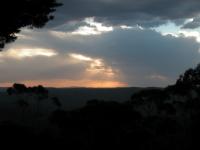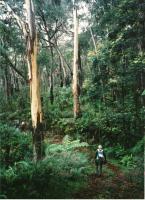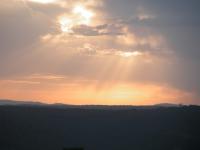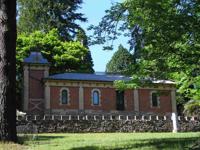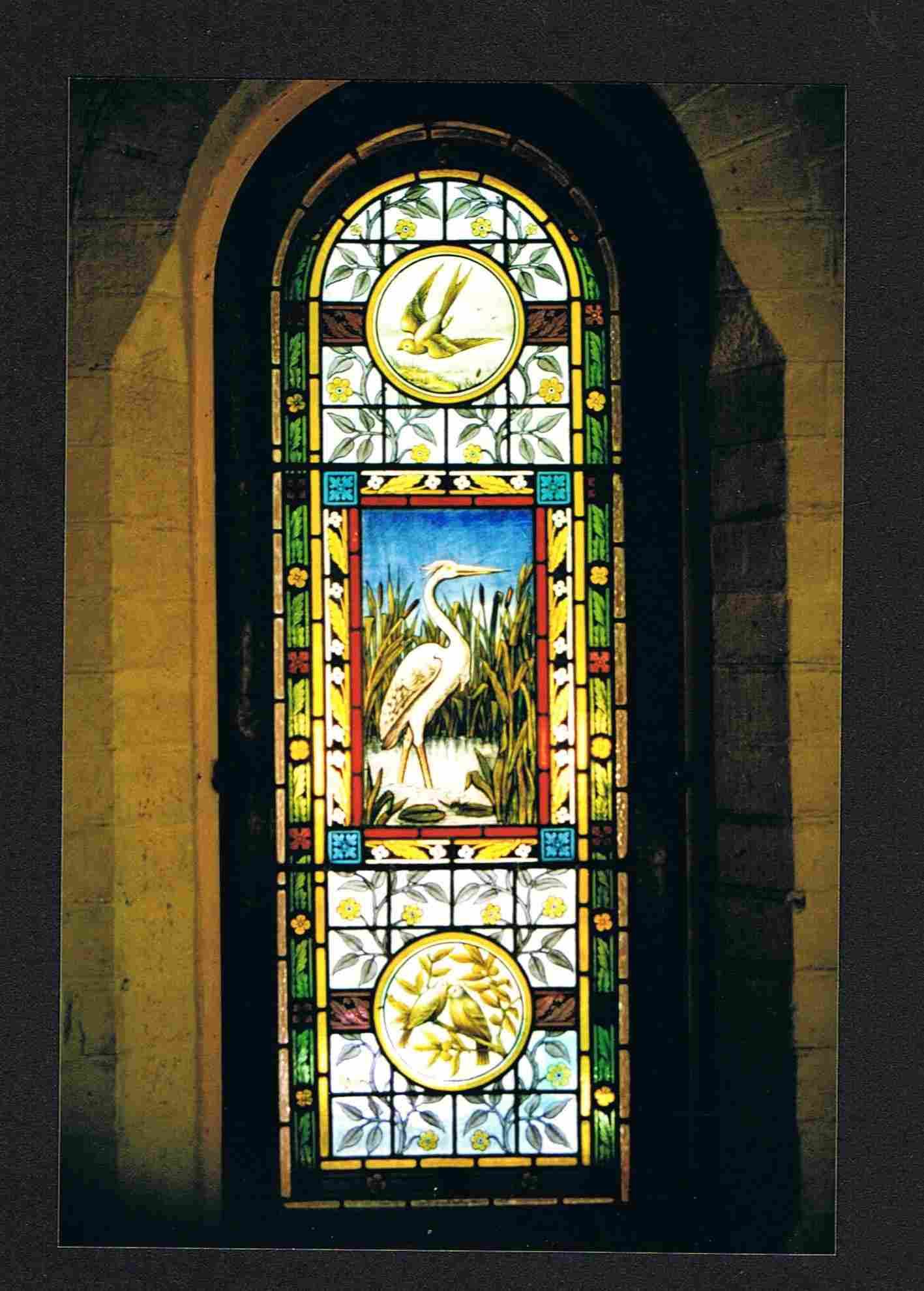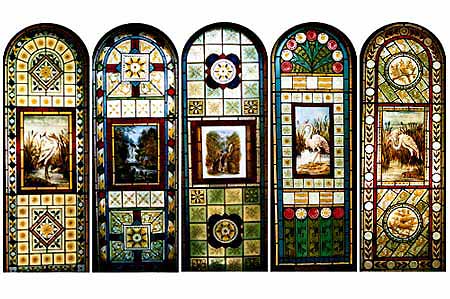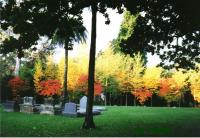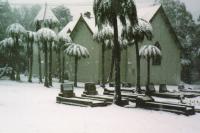Things to Do
There are a host of things to do and see around the villages - walks, historical buildings, picnics, camping and lookouts over spectacular wilderness areas.
Both villages are very small and can be easily accessed by foot or a short car trip. We encourage you to explore at a leisurely pace and kindly ask that you leave nothing but footprints, and take nothing but photographs.
Points of Interest
- Details
In addition to the many walks and gardens in Mount Wilson there are also lookouts with wonderful views across the mountains and down into deep valleys, and interesting reserves.
Lookouts - Wynnes Rocks Lookout and DuFaurs Rocks
Spectacular views are seen from these two sites, over Bowen’s Creek to Mt Tomah for the first and the Wollangambe Crater from the latter. Walks to Chinaman’s Hat (15 minutes from DuFaur’s Rocks) and Pheasant’s Cave (about 1 hour). A shelter shed is located at Wynnes Rocks Lookout.
Marcus Clark Reserve
On The Avenue, the same side as the Fire Station.
There is a short walk through an arboretum of the native plants of the sandstone soil.
Waterfall Reserve
Shelter shed and toilet. Waterfall Walk through the rainforest is a must, about 1 hour.
Nearby is Gregson Park , together with Jefferson Bridge which straddles Waterfall Creek, links the bottom end of Waterfall Road and Wyndham Avenue.
Happy Valley
Shelter shed. Try the Happy Valley Walk, approximately 1 hour from the picnic area.
Sloan Reserve
Tucked in below the road at Ferny Corner, located on the walk along on The Avenue.
Sites Managed by the MWPA
There are a number of sites managed by the Mt Wilson Progress Association (MWPA), some of which are listed above and elsewhere.
Turkish Bath Museum
- Details
This unique heritage listed building is situated within the Wynstay Estate at the end of The Avenue, Mount Wilson. It was the one of the first properties to be established in Mount Wilson, as early as 1875, by Mr Richard Wynne who also established the Wynne Landscape & Sculpture Prize in 1895.
The building was in use for a few years for its initial purpose, as a Turkish Bath, but now partly restored it houses a museum of local history operated by the Mt Wilson and Mt Irvine Historical Society.
The building itself is very stylish, featuring many original features including arched windows of stained and hand painted glass. It has exterior walls of polychrome brickwork with Italianate decoration and an elaborate turret with cast iron finials and roof decoration.
The wrought iron gate to the Museum area was recently made by Scott Leonard, a local resident and metalworker.
The museum regularly holds exhibitions about the history of Mt Wilson and Mt Irvine and its interesting personalities.
The Turkish Bath Museum page has more details of this fascinating building including opening dates. Booked tours can be arranged at any time via the Society’s email address - This email address is being protected from spambots. You need JavaScript enabled to view it.
Horticulture & Plant Nurseries
- Details
Click on the heading of each nursery for further information
Rare & unusal plants for sale
25 Queens Avenue, Mt Wilson
02 4756 2019
Rare plant nursery - open every Wednesday
17 Galwey Lane, Mt Wilson
02 4756 2121
St Georges Anglican Church
- Details
This church is located in The Avenue and is part of the Blackheath Parish. Services are held on the second Sunday of the month at 3.00 p.m. All visitors are welcome. Information on The Anglican Parish of Blackheath is here and enquiries can be made to the minister, Tim McIver on 0425 285 295.
Donations to the St Georges Anglican Church Repair & Maintenance fund should be direct deposited to BSB: 112879, Account: 046483749. Donations to the Parish of Blackheath should be deposited to BSB: 112879, Account: 046518471.
St Georges Church was built in 1915 as a memorial to Henry Marcus Clark by his family. Henry Marcus Clark bought the property Balangra in 1910, after moving much of the original house to where Sefton Cottage now stands, he built a new home, naming it Sefton Hall.
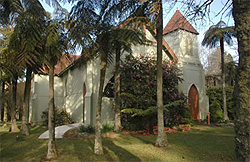 Land for the church was donated by Richard Owen Wynne, of Wynstay, one of the first properties to be established on Mt Wilson. Cliff O'Rourke and Albert Kirk, using a bullock team, cleared massive trees and thick undergrowth on the site. They were directed not to damage the tree ferns, with the result that many of them are standing today in the churchyard. Cliff's horse team was used to transport the building materials from the railway at Bell. Fibro, the new wonder material imported from England and France, was chosen for its qualities of lightness and ease of construction. One of the builders working at Sefton Hall undertook to build the church, and as he was quite elderly, Albert Kirk helped by doing the high work such as nailing the roof timbers. As this was the time of the First World War, many Australian men were fighting overseas, including three older Kirk brothers, however Albert's weak chest prevented him from enlisting.
Land for the church was donated by Richard Owen Wynne, of Wynstay, one of the first properties to be established on Mt Wilson. Cliff O'Rourke and Albert Kirk, using a bullock team, cleared massive trees and thick undergrowth on the site. They were directed not to damage the tree ferns, with the result that many of them are standing today in the churchyard. Cliff's horse team was used to transport the building materials from the railway at Bell. Fibro, the new wonder material imported from England and France, was chosen for its qualities of lightness and ease of construction. One of the builders working at Sefton Hall undertook to build the church, and as he was quite elderly, Albert Kirk helped by doing the high work such as nailing the roof timbers. As this was the time of the First World War, many Australian men were fighting overseas, including three older Kirk brothers, however Albert's weak chest prevented him from enlisting.
Timber battens were used to cover joins in the fibro walls, and the roof was also made of fibro, cut into tiles, painted and then carefully nailed in place. The structural timbers are Oregon from North America and the roof is lined with Baltic pine from northern Europe. The windows, it is thought, were made in Sydney, while the pressed metal surrounds at the base of the building were popular at the time as a cheaper imitation of sandstone.
The organ originally stood halfway down the church on the right hand side. In the 1970s the present organ was donated by the Wentworth Falls Anglican Church and placed in its present position. This is an American organ and although quite old, is one of the best of its type. It was restored in 1994.
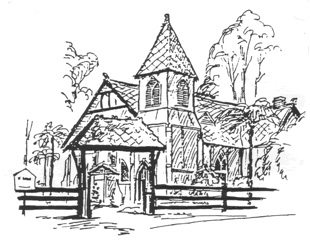 St Georges was consecrated in 1916, and was served for many years by the Rector of Mt Victoria and Hartley Parish. One or sometimes two services were held each month, with an occasional christening or wedding. The Rector would quite often visit the folk living here, arriving with the mailman, or later in a hire car, and then walking around the village on foot. People still speak with great warmth of the Reverend Dorph, who in the 1930s and 40s provided understanding, humour, compassion and learning as he visited the people of this rather isolated community. In the 1960s the boundaries were altered so that Mt Victoria and Mt Wilson were included in the Parish of Blackheath.
St Georges was consecrated in 1916, and was served for many years by the Rector of Mt Victoria and Hartley Parish. One or sometimes two services were held each month, with an occasional christening or wedding. The Rector would quite often visit the folk living here, arriving with the mailman, or later in a hire car, and then walking around the village on foot. People still speak with great warmth of the Reverend Dorph, who in the 1930s and 40s provided understanding, humour, compassion and learning as he visited the people of this rather isolated community. In the 1960s the boundaries were altered so that Mt Victoria and Mt Wilson were included in the Parish of Blackheath.
In the grounds, members of the village have been buried over the years. Some of the graves date back to the 1920s with descendants of the original families buried here.
Plaques beneath the trees are for ashes of a number of past residents of the village.
Today the congregation is made up of a small group from the Mt Wilson and Mt Irvine communities. These local people maintain and care for the church, the garden and grounds. It is open on the second Sunday of each month, and at other times on request.
Walks along Bells Line of Road
- Details
Simple safety precautions that should be undertaken before and during any moderate to long walk in the Upper Blue Mountains are described pdf Think before you trek brochure (503 KB) .
If you are attempting a more ambitious walk in the surrounding national parks, please understand that weather conditions in the Blue Mountains are likely to change rapidly. All walkers should be aware of the possibility of heavy rain, fog and the likelihood of a rapid rise in water levels on all rivers and streams. Walkers and canyoners are strongly advised to take extra food and warm gear as it is possible to be stranded. No one should attempt these walks without an experienced person as part of the group. A rescue beacon, EPIRB or similar equipment is also strongly recommended. As noted above, mobile phones DO NOT work in most areas and should not be relied upon.
Subcategories
Pick your own walnuts and chestnuts
Picking your own walnuts and chestnuts is a fun activity for the family or just the opportunity to find fresh high quality nuts for eating or cooking. There are two seasons for walnuts. The green walnut season is in December and some properties are open, so you can use this special product for your own favourite family recipes. During the main season in autumn at both Mt Irvine and Mt Wilson, several properties open during March and April each year for mature ripe walnuts and chestnuts and they invite people to visit and pick their own nuts.
So, come and pick your own walnuts and chestnuts. There are established nut orchards with large, good quality, fresh chestnuts and walnuts. Chestnuts need gloves to pick up the spiky shells which have fallen to the ground, and break them open to get the chestnuts. Walnuts are just picked from the ground.
Drive around the villages and look for signs outside properties where you can pick nuts. Some properties are regulars each season and other properties advertise only when they have nuts available for picking.
The regular properties open each season are in the table below. It is a good idea to call first and check when they are open.
